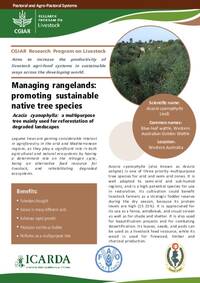Managing rangelands: promoting sustainable native tree species: Acacia cyanophylla: a multipurpose tree mainly used for reforestation of degraded landscapes

Authors:
Acacia cyanophylla (also known as Acacia saligna) is one of three priority multipurpose tree species for arid and semi-arid zones. It is well adapted to semi-arid and sub-humid regions, and is a high potential species for use in restoration. Its cultivation could benefit livestock farmers as a strategic fodder reserve during the dry season, because its protein levels are high (15-21%). It is appreciated for its use as a fence, windbreak, and visual screen as well as for shade and shelter. It is also used for beautification projects and for combating desertification. Its leaves, seeds, and pods can be used as a livestock feed resource, while its wood is used for firewood, timber and charcoal production.
